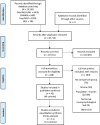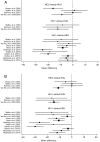Neurodevelopment in Young Children Born to HIV-Infected Mothers: A Meta-analysis
- PMID: 29374109
- PMCID: PMC5810606
- DOI: 10.1542/peds.2017-2888
Neurodevelopment in Young Children Born to HIV-Infected Mothers: A Meta-analysis
Abstract
Context: HIV-infected (HIV+) children have worse neurodevelopmental outcomes compared with HIV-uninfected children. However, little is known regarding the differences in neurodevelopment between young HIV+ children, HIV-exposed but uninfected (HEU) children, and HIV-unexposed and uninfected (HUU) children.
Objective: To systematically review and meta-analyze data on neurodevelopmental performance between young HIV+, HEU, and HUU children.
Data sources: We systematically searched the following electronic bibliographic databases: Ovid Medline, Embase, PsycINFO, Education Resources Information Center, and the Cochrane Database of Systematic Reviews.
Study selection: Studies were selected on the basis of defined inclusion criteria. Titles, abstracts, and full texts were assessed by 2 independent reviewers.
Data extraction: Data were extracted by 2 independent reviewers and cross-checked by 2 additional reviewers.
Results: Forty-five studies were identified for inclusion in the systematic review, and of these, 11 were included in the meta-analysis on the basis of availability of Bayley Scales of Infant and Toddler Development scores. Within the meta-analysis, when compared with their HUU peers, HIV+ and HEU children had lower cognitive and motor scores. HIV+ and HEU children with antiretroviral (ARV) exposure had lower cognitive and motor scores compared with those without ARV exposure.
Limitations: We were unable to control adequately for intravenous drug use, geographic location, or quality of the assessment independently.
Conclusions: Both HIV+ and HEU children had worse developmental outcomes compared with HUU children. HIV+ and HEU children with ARV exposure also had worse developmental outcomes compared with those without exposure; however, these results should be interpreted with caution. More research is needed to identify the impact of ARV exposure on young children.
Copyright © 2018 by the American Academy of Pediatrics.
Conflict of interest statement
POTENTIAL CONFLICT OF INTEREST: The authors have indicated they have no potential conflicts of interest to disclose.
Figures





References
-
- Abubakar A, Van Baar A, Van de Vijver FJ, Holding P, Newton CR. Paediatric HIV and neurodevelopment in sub-Saharan Africa: a systematic review. Trop Med Int Health. 2008;13(7):880–887 - PubMed
-
- Sherr L, Croome N, Parra Castaneda K, Bradshaw K, Romero RH. Developmental challenges in HIV infected children—an updated systematic review. Child Youth Serv Rev. 2014;45:74–89
-
- Filteau S. The HIV-exposed, uninfected African child. Trop Med Int Health. 2009;14(3):276–287 - PubMed
Publication types
MeSH terms
Grants and funding
LinkOut - more resources
Full Text Sources
Other Literature Sources
Medical

